
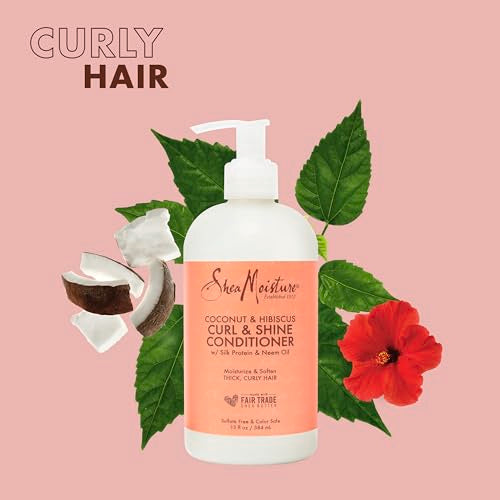
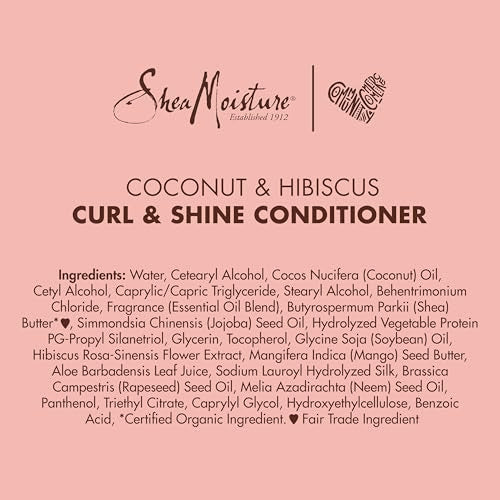
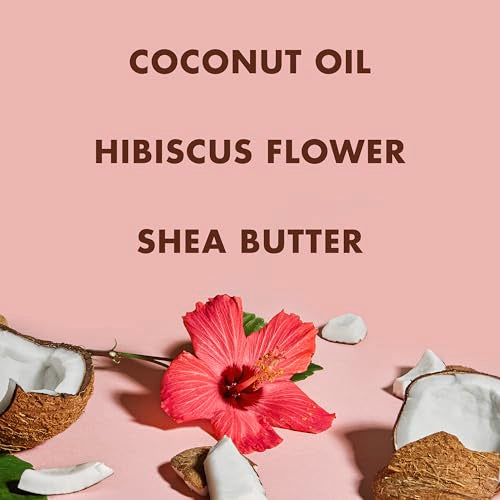
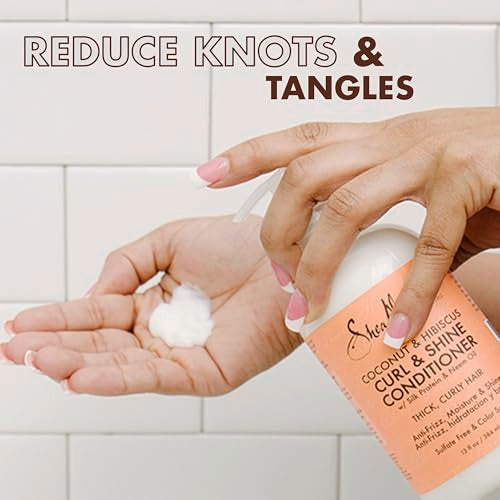
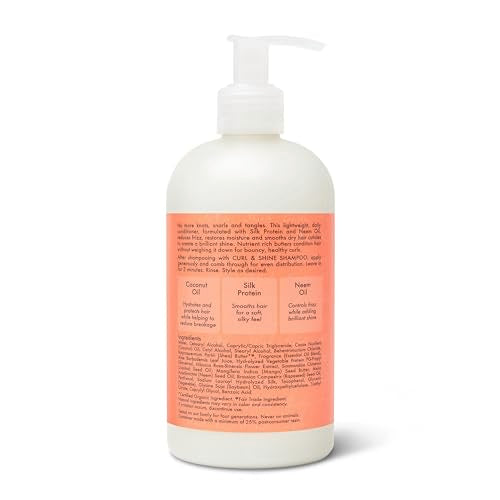
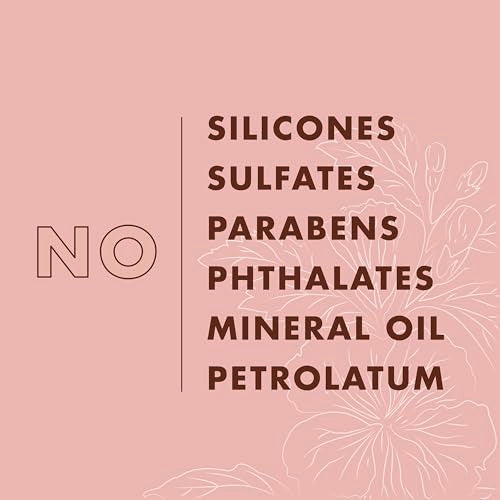
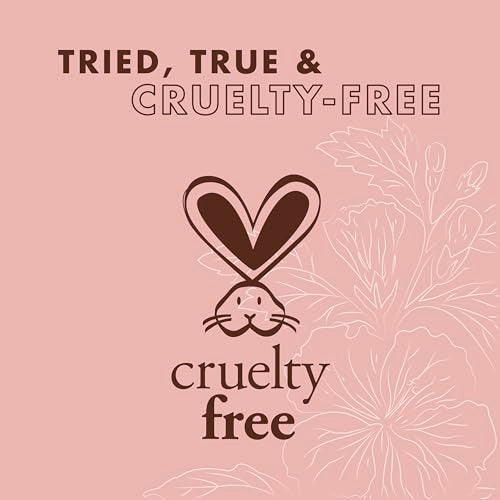
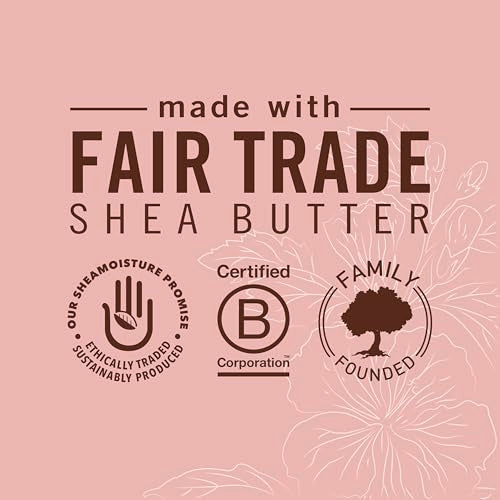
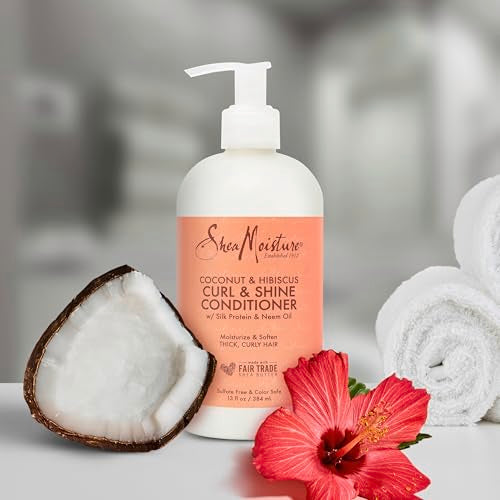
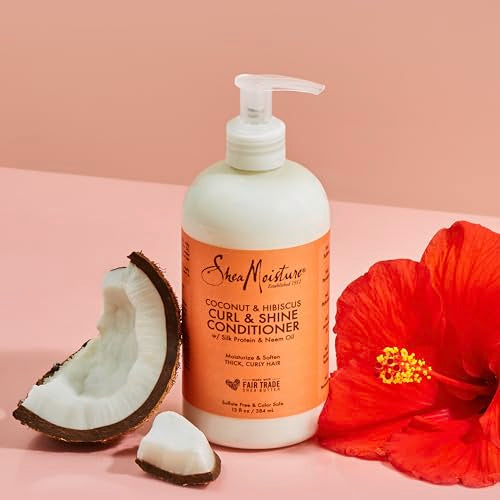
SheaMoisture Curl & Shine Conditioner - Hydrates & Defines Curls with Neem Oil - 13 oz


Behentrimonium Chloride
High RiskBehentrimonium chloride is a quaternary ammonium compound primarily used as a conditioning agent in hair and skin care products. It functions as an emulsifier and surfactant, helping to improve texture and manageability of hair.
Sustai Insights
Behentrimonium chloride offers functional benefits as a hair conditioner and emulsifier. However, it is associated with moderate allergenic potential and has high use restrictions due to regulatory concerns. It poses low risks for carcinogenicity and developmental toxicity but has been noted for neurotoxicity. Environmental risks include potential pollution and low biodegradability. Overall, the ingredient is assessed as high risk, and users should consider alternatives such as natural conditioners.
Fragrance
High RiskFragrance refers to a mixture of aromatic compounds used in products to provide scent. It is commonly listed as 'fragrance' or 'parfum' on product labels and can serve various functions, including enhancing user experience and masking undesirable odors.
Sustai Insights
Fragrance offers functional benefits by improving product appeal; however, it poses significant health risks, notably a high likelihood of causing allergies and allergic contact dermatitis. Environmental risks include potential pollution and endocrine disruption, though its overall carcinogenicity is low. Regulatory bodies have noted concerns regarding its use, leading to a high-risk classification. Safe usage practices should be observed, and alternatives such as natural essential oils are recommended for those sensitive to synthetic fragrances.
Benzoic Acid
Medium RiskBenzoic acid is a naturally occurring and synthetically produced compound commonly used as a preservative in food and cosmetic products. It helps inhibit the growth of mold, yeast, and some bacteria, thus extending shelf life and maintaining product quality.
Sustai Insights
Benzoic acid is effective as a preservative, ensuring product stability and safety. It is generally considered to have low health risks, with minimal concerns regarding carcinogenicity, allergies, or reproductive toxicity. Environmental risks are moderate, as it is not bioaccumulative but can be a pollutant. Regulatory bodies do impose certain restrictions on its use in various products. Safe usage practices should be followed to mitigate any potential risks. Available alternatives include sorbic acid and other natural preservatives, which may offer similar benefits with potentially lower environmental impact. The overall risk level is assessed as medium.
Triethyl Citrate
Medium RiskTriethyl citrate is a triester of ethyl alcohol and citric acid, commonly used as a solvent, plasticizer, and fragrance ingredient in cosmetic and personal care products. It functions effectively in formulations, contributing to product texture and stability.
Sustai Insights
Triethyl citrate offers functional benefits such as enhancing product texture and acting as a solvent. It is considered biodegradable and has low potential for bioaccumulation. However, it presents moderate allergenic risk and low concerns regarding carcinogenicity and reproductive toxicity. Regulatory bodies have placed some restrictions on its use in verified products. Overall, it is assessed as a medium risk ingredient, necessitating safe usage practices.
Glycerin
Medium RiskGlycerin (also called glycerol) is a naturally occurring compound commonly used in personal care and cosmetic products. It functions as a humectant, attracting moisture to the skin, and is also utilized as a solvent and emollient to enhance product texture and stability.
Sustai Insights
Glycerin is valued for its effective moisturizing properties and biodegradability, making it a widely accepted ingredient in formulations. It poses low health risks, including low concerns for carcinogenicity and allergies. However, moderate use restrictions exist due to regulatory guidelines. While glycerin does not significantly contribute to environmental pollution, its production process should be ethically sourced. Overall, glycerin holds a medium risk level, emphasizing the importance of safe usage practices and considering sustainable alternatives.
Stearyl Alcohol
Low RiskStearyl alcohol is a compound produced from the hydrogenation of stearic acid, commonly used in cosmetic formulations as an emulsifier and thickening agent. It helps stabilize products by blending oil and water phases, enhancing texture and consistency.
Sustai Insights
Stearyl alcohol provides functional benefits as an emulsifier and stabilizer, contributing to improved product texture. It is generally regarded as safe with low concerns for cancer, allergies, and reproductive toxicity. However, it may cause moderate skin, eye, or respiratory irritation. Regulatory bodies do not impose significant restrictions, indicating a low overall risk. While it poses minimal health and environmental hazards, caution is advised for sensitive individuals. Alternatives like cetyl alcohol or plant-based emulsifiers may offer safer options for formulators.
Azadirachta Indica (Neem) Seed Oil
Low RiskAzadirachta indica (neem) seed oil is derived from the seeds of the neem tree. It is commonly used in cosmetic and personal care products for its potential properties as an emollient and its traditional use in herbal medicine. Its applications include skin care, hair care, and as an insect repellent.
Sustai Insights
Neem seed oil offers functional benefits such as moisturizing and potential antimicrobial properties, making it useful in personal care formulations. It is considered sustainably sourced and biodegradable. Health risks are low, with minimal concerns regarding carcinogenicity, allergies, or reproductive toxicity. Environmental risks are also low, with no significant pollutant or bioaccumulation potential. Regulatory status shows no current restrictions. Overall, it is assessed to have a low risk, making it a favorable choice in formulations.
Sodium Lauroyl Hydrolyzed Silk
Low RiskSodium lauroyl hydrolyzed silk is a sodium salt of hydrolyzed silk protein, used primarily in cosmetic and personal care products for its emollient properties. It helps to improve the texture and moisture retention of formulations, contributing to skin and hair conditioning.
Sustai Insights
Sodium lauroyl hydrolyzed silk offers functional benefits such as enhanced moisture retention and improved texture in formulations. It is considered low risk for known health concerns, including carcinogenicity and allergenic potential. Environmental risks are also low, with no evidence of bioaccumulation or significant pollution. Regulatory status is clear, with no current restrictions. Safe usage practices should be followed, and while alternatives exist, they may not replicate the same conditioning properties. Overall, the assessment indicates a low risk associated with this ingredient.
Disodium Phosphate
Low RiskDisodium phosphate is an inorganic salt commonly used in various applications, including food processing and personal care products. It serves as a buffering agent and stabilizer, helping to maintain pH levels and enhance product efficacy.
Sustai Insights
Disodium phosphate is recognized for its functional benefits, such as acting as an effective buffering agent in formulations. Health risks are low, with minimal concerns regarding carcinogenicity, allergies, or reproductive toxicity. Environmental impact is also low, with no significant pollutant potential. Regulatory bodies, including the FDA, do not impose restrictions on its use. Overall, the risk level associated with this ingredient is low, making it a viable option in product formulations.
Polysorbate 60
Low RiskPolysorbate 60 (Tween-60) is a sorbitol-based non-ionic surfactant commonly used as an emulsifier and stabilizer in various cosmetic and food products. It helps to blend oil and water, enhancing texture and consistency.
Sustai Insights
Polysorbate 60 offers functional benefits as an effective emulsifier, promoting product stability and texture. It is generally considered safe with low concerns regarding cancer, allergies, and reproductive toxicity. Environmental risks are minimal, with no significant pollutant or bioaccumulation potential. Regulatory bodies have not issued severe warnings, indicating a low overall risk. Safe usage practices include adhering to recommended concentrations, with alternatives like glyceryl stearate available for those seeking more sustainable options.
Mangifera Indica (Mango) Seed Butter
Low RiskMangifera indica (mango) seed butter is a fat extracted from the seeds of the mango fruit. It is commonly used in cosmetic formulations for its emollient and moisturizing properties, providing a smooth texture and enhancing product stability.
Sustai Insights
Mango seed butter offers functional benefits such as effective moisturization and skin conditioning, derived from its fatty acid profile. It is considered low risk regarding health concerns, with minimal allergenic potential and no significant environmental hazards. Regulatory agencies have not imposed restrictions on its use. Overall, the ingredient is assessed as low risk, making it a suitable option for various cosmetic products. Alternatives include other plant-based butters like shea or cocoa butter for similar properties.
Glycine Soja (Soybean) Oil
Low RiskGlycine soja (soybean) oil is derived from the seeds of the soybean plant and is commonly used in cosmetic formulations for its emollient properties. It functions as a moisturizer and skin conditioning agent, enhancing the texture and feel of products.
Sustai Insights
Glycine soja (soybean) oil offers functional benefits such as effective skin moisturization and conditioning. It is generally recognized as low-risk for health concerns, with minimal allergenic potential and no significant environmental hazards reported. Regulatory bodies have not imposed restrictions on its use. Overall, this ingredient is assessed as low risk, making it a suitable option for various cosmetic applications.
Hydroxyethylcellulose
Low RiskHydroxyethylcellulose is a modified cellulose polymer used primarily as a thickening agent and stabilizer in various cosmetic and personal care products. It is soluble in water and helps to improve the texture and viscosity of formulations, enhancing their usability and performance.
Sustai Insights
Hydroxyethylcellulose offers functional benefits such as effective thickening and stabilization in formulations, contributing to product texture. It is generally considered low-risk in terms of health, with minimal concerns regarding carcinogenicity, allergens, or reproductive toxicity. Environmentally, it poses low risks and is not known to be bioaccumulative. Regulatory bodies have not imposed significant restrictions on its use. Safe practices include adhering to recommended concentrations, and while alternatives exist, hydroxyethylcellulose remains a low-risk ingredient overall.
Brassica Campestris (Rapeseed) Seed Oil
Low RiskBrassica campestris (rapeseed) seed oil is a vegetable oil derived from the seeds of the rapeseed plant. It is primarily used in cosmetic formulations for its emollient properties, enhancing skin feel and moisture retention.
Sustai Insights
Brassica campestris (rapeseed) seed oil offers functional benefits as a moisturizer and skin conditioner due to its emollient characteristics. It is sustainably sourced and generally considered low risk for health impacts, with minimal concerns regarding carcinogenicity, allergies, and reproductive toxicity. Environmental risks are also low, with no significant pollutant or bioaccumulation potential identified. Regulatory bodies have not imposed restrictions on its use. Recommendations include normal cosmetic application, and while alternatives exist, this ingredient stands out for its safety profile and functional attributes.
Hibiscus Rosa Sinensis (Chinese Hibiscus) Extract
Low RiskHibiscus rosa-sinensis extract is an extract obtained from the flowers of the Chinese hibiscus plant. It is commonly used in cosmetic and personal care products for its potential moisturizing and antioxidant properties.
Sustai Insights
Hibiscus rosa-sinensis extract offers functional benefits, including moisturization and antioxidant activity, making it suitable for skin care formulations. It is not associated with significant health risks such as carcinogenicity or irritations, and its environmental impact is minimal, posing low pollution risk. Regulatory assessments indicate no restrictions on its use. Overall, the ingredient is safe for cosmetic applications with a low risk profile. Alternatives for similar benefits include other plant extracts like aloe vera or green tea.
Water
Low RiskWater is a clear, colorless liquid essential for various biological processes. It serves as a solvent in formulations, facilitating the dissolution of other ingredients and enhancing product texture and application. Additionally, water plays a crucial role in hydration and is a key component in many cosmetic and personal care products.
Sustai Insights
Water is an effective solvent and hydrator, contributing to the texture and efficacy of formulations. It is biodegradable and generally regarded as safe, with low concerns regarding carcinogenicity, allergies, and reproductive toxicity. However, excessive water usage can lead to environmental concerns, particularly regarding resource depletion. Regulatory bodies do not impose restrictions on water use in cosmetics. Overall, the risks associated with water are low, making it a safe and essential ingredient.
Panthenol
Low RiskPanthenol, a derivative of vitamin B5, is commonly used in cosmetic formulations for its moisturizing and skin-conditioning properties. It acts as a humectant, helping to retain moisture in the skin and hair, thereby improving hydration and texture.
Sustai Insights
Panthenol offers functional benefits such as effective hydration and skin conditioning, making it valuable in various cosmetic products. It is considered low risk regarding health impacts, with minimal concerns about carcinogenicity, allergies, or reproductive toxicity. Environmental risks are also low, with no significant pollutant or bioaccumulation potential. Regulatory bodies have not imposed restrictions on its use. Safe usage practices include adhering to recommended concentrations. Alternatives like glycerin may provide similar moisturizing benefits, but overall, panthenol is assessed as a low-risk ingredient.
Tocopherol
Low RiskTocopherols are a class of naturally occurring compounds, primarily known for their role as antioxidants. They are commonly used in cosmetic and skincare products to help stabilize formulations and protect ingredients from oxidative damage.
Sustai Insights
Tocopherols provide functional benefits such as antioxidant protection and skin conditioning. They are generally recognized as safe, with low concerns regarding carcinogenicity, allergies, and reproductive toxicity. However, enhanced skin absorption and potential endocrine disruption are noted. Regulatory bodies have not imposed significant restrictions on tocopherols, categorizing the overall risk as low. Safe usage practices should be observed, and while alternatives exist, tocopherols remain a viable option in formulations.
Cetyl Alcohol
Low RiskCetyl alcohol is a long-chain organic alcohol commonly used in cosmetic formulations. It serves as an emollient, emulsifier, and thickening agent, enhancing the texture and stability of products. Cetyl alcohol is derived from natural sources, such as coconut or palm oil, and is often included in creams, lotions, and hair conditioners.
Sustai Insights
Cetyl alcohol offers functional benefits as an emollient and emulsifier, improving product texture and stability. It is biodegradable and sourced from renewable materials, contributing to sustainability. Health risks are minimal, with low concerns for carcinogenicity, allergies, or reproductive toxicity. Environmental impact is also low, with no significant pollutant or bioaccumulation potential. Regulatory bodies have not placed restrictions on its use, indicating a favorable safety profile. Overall, cetyl alcohol is assessed as low risk, and safe usage practices include ensuring proper formulation concentrations.
Caprylyl Glycol
Low RiskCaprylyl glycol (1,2-octanediol) is a multifunctional cosmetic ingredient primarily used as a skin-conditioning agent and preservative. It is derived from caprylic acid, a fatty acid found in coconut oil, and is commonly included in personal care products for its moisturizing properties.
Sustai Insights
Caprylyl glycol offers functional benefits such as acting as an effective humectant and preservative, enhancing skin hydration and product stability. It is considered to have low health risks, with no significant concerns regarding carcinogenicity, allergies, or reproductive toxicity. Environmentally, it poses minimal risks, being non-bioaccumulative and not linked to pollution. Regulatory assessments affirm its safety, with no major advisories against its use. Overall, the ingredient is assessed to have a low risk, making it a suitable choice in cosmetic formulations.
Cetearyl Alcohol
Low RiskCetearyl alcohol is a mixture of cetyl and stearyl alcohol, primarily used as an emulsifier and thickener in cosmetic formulations. It helps stabilize products, improve texture, and enhance moisturizing properties, making it common in creams and lotions.
Sustai Insights
Cetearyl alcohol offers functional benefits as an effective emulsifier and skin-conditioning agent, contributing to product stability and texture. It is generally recognized as safe, with low concerns for carcinogenicity, allergies, or reproductive toxicity. Environmental risks are minimal, as it is biodegradable and has low pollutant potential. Regulatory bodies have not imposed significant restrictions on its use. Overall, cetearyl alcohol is assessed to carry low risk, making it a suitable ingredient choice in cosmetic products.
Caprylic/Capric Triglyceride
Low RiskCaprylic/capric triglyceride is a mixed triester derived from coconut oil and glycerin, primarily used as an emollient and skin-conditioning agent in cosmetic formulations. It serves to improve the texture and spreadability of products while providing a lightweight, non-greasy feel on the skin.
Sustai Insights
Caprylic/capric triglyceride offers functional benefits as an effective emollient, enhancing skin hydration without clogging pores. It is biodegradable, contributing to sustainability. Health risks are low, with minimal concerns regarding carcinogenicity, allergies, or reproductive toxicity. Environmental impacts are also low, with no known pollutant status. Regulatory assessments indicate no current restrictions. Overall, this ingredient presents a low risk profile, making it a safe choice in cosmetic applications.
Cocos Nucifera (Coconut) Oil
Low RiskCocos Nucifera (Coconut) Oil is derived from the kernels of the coconut palm. It is primarily used in cosmetic formulations for its emollient and moisturizing properties, making it suitable for skin and hair care products.
Sustai Insights
Coconut oil serves as an effective moisturizer and emollient, promoting skin hydration and softness. It is sustainably sourced and biodegradable. Health risks are minimal, with low concerns regarding carcinogenicity, allergens, and reproductive toxicity. Environmental impact is also low, as it does not contribute significantly to pollution or bioaccumulation. Regulatory bodies have not issued restrictions on its use. Overall, coconut oil presents a low risk for health and environmental concerns, making it a safe ingredient in cosmetic products.
Butyrospermum Parkii (Shea) Butter
Low RiskButyrospermum parkii (shea) butter is a vegetable fat derived from the nuts of the shea tree. It is commonly used in cosmetic formulations for its emollient properties, providing moisture and improving skin texture. Additionally, shea butter is known for its ability to enhance the stability of products and deliver a creamy texture.
Sustai Insights
Shea butter offers functional benefits as an effective moisturizer, enhancing skin barrier function and texture. It is sustainably sourced and biodegradable, contributing to eco-friendliness. Health-wise, it is associated with low risks for carcinogenicity, allergies, and reproductive toxicity. Environmental impacts are minimal, with no significant pollutant potential identified. Regulatory assessments indicate no current restrictions. Overall, the ingredient presents a low risk, making it a favorable choice in cosmetic formulations.
Simmondsia Chinensis (Jojoba) Seed Oil
Low RiskSimmondsia chinensis (jojoba) seed oil is extracted from the seeds of the jojoba plant. It is commonly used in cosmetics for its moisturizing properties and ability to mimic human sebum, making it beneficial for skin and hair care formulations.
Sustai Insights
Jojoba seed oil offers functional benefits such as effective moisturization and emollience, contributing to skin hydration and smoothness. It is sustainably sourced and biodegradable. Health risks are low, with minimal concerns regarding carcinogenicity, allergies, and reproductive toxicity. Environmental risks are also low, as it does not significantly contribute to pollution or bioaccumulation. Currently, there are no regulatory restrictions on its use. Overall, the risk level is low, and it is considered a safe ingredient with no significant adverse effects.
Aloe Barbadensis (Aloe Vera) Leaf Juice
Low RiskAloe barbadensis (aloe vera) leaf juice is derived from the succulent aloe vera plant, known for its hydrating and soothing properties. It is commonly used in cosmetic formulations for its moisturizing effects and is often included in products aimed at skin care and healing.
Sustai Insights
Aloe vera leaf juice offers functional benefits as a moisturizer and skin soothing agent, while being sustainably sourced and biodegradable. Health risks are low, with minimal concerns regarding carcinogenicity, allergies, and reproductive toxicity. Environmental impact is also low, with no significant pollutants identified. Regulatory agencies impose few restrictions. Overall, the ingredient poses a low risk, making it a favorable choice in cosmetic formulations.
Benzoic Acid
Medium RiskBenzoic acid is a naturally occurring and synthetically produced compound commonly used as a preservative in food and cosmetic products. It helps inhibit the growth of mold, yeast, and some bacteria, thus extending shelf life and maintaining product quality.
Sustai Insights
Benzoic acid is effective as a preservative, ensuring product stability and safety. It is generally considered to have low health risks, with minimal concerns regarding carcinogenicity, allergies, or reproductive toxicity. Environmental risks are moderate, as it is not bioaccumulative but can be a pollutant. Regulatory bodies do impose certain restrictions on its use in various products. Safe usage practices should be followed to mitigate any potential risks. Available alternatives include sorbic acid and other natural preservatives, which may offer similar benefits with potentially lower environmental impact. The overall risk level is assessed as medium.
Triethyl Citrate
Medium RiskTriethyl citrate is a triester of ethyl alcohol and citric acid, commonly used as a solvent, plasticizer, and fragrance ingredient in cosmetic and personal care products. It functions effectively in formulations, contributing to product texture and stability.
Sustai Insights
Triethyl citrate offers functional benefits such as enhancing product texture and acting as a solvent. It is considered biodegradable and has low potential for bioaccumulation. However, it presents moderate allergenic risk and low concerns regarding carcinogenicity and reproductive toxicity. Regulatory bodies have placed some restrictions on its use in verified products. Overall, it is assessed as a medium risk ingredient, necessitating safe usage practices.
Behentrimonium Chloride
High RiskBehentrimonium chloride is a quaternary ammonium compound primarily used as a conditioning agent in hair and skin care products. It functions as an emulsifier and surfactant, helping to improve texture and manageability of hair.
Sustai Insights
Behentrimonium chloride offers functional benefits as a hair conditioner and emulsifier. However, it is associated with moderate allergenic potential and has high use restrictions due to regulatory concerns. It poses low risks for carcinogenicity and developmental toxicity but has been noted for neurotoxicity. Environmental risks include potential pollution and low biodegradability. Overall, the ingredient is assessed as high risk, and users should consider alternatives such as natural conditioners.
Stearyl Alcohol
Low RiskStearyl alcohol is a compound produced from the hydrogenation of stearic acid, commonly used in cosmetic formulations as an emulsifier and thickening agent. It helps stabilize products by blending oil and water phases, enhancing texture and consistency.
Sustai Insights
Stearyl alcohol provides functional benefits as an emulsifier and stabilizer, contributing to improved product texture. It is generally regarded as safe with low concerns for cancer, allergies, and reproductive toxicity. However, it may cause moderate skin, eye, or respiratory irritation. Regulatory bodies do not impose significant restrictions, indicating a low overall risk. While it poses minimal health and environmental hazards, caution is advised for sensitive individuals. Alternatives like cetyl alcohol or plant-based emulsifiers may offer safer options for formulators.
Azadirachta Indica (Neem) Seed Oil
Low RiskAzadirachta indica (neem) seed oil is derived from the seeds of the neem tree. It is commonly used in cosmetic and personal care products for its potential properties as an emollient and its traditional use in herbal medicine. Its applications include skin care, hair care, and as an insect repellent.
Sustai Insights
Neem seed oil offers functional benefits such as moisturizing and potential antimicrobial properties, making it useful in personal care formulations. It is considered sustainably sourced and biodegradable. Health risks are low, with minimal concerns regarding carcinogenicity, allergies, or reproductive toxicity. Environmental risks are also low, with no significant pollutant or bioaccumulation potential. Regulatory status shows no current restrictions. Overall, it is assessed to have a low risk, making it a favorable choice in formulations.
Sodium Lauroyl Hydrolyzed Silk
Low RiskSodium lauroyl hydrolyzed silk is a sodium salt of hydrolyzed silk protein, used primarily in cosmetic and personal care products for its emollient properties. It helps to improve the texture and moisture retention of formulations, contributing to skin and hair conditioning.
Sustai Insights
Sodium lauroyl hydrolyzed silk offers functional benefits such as enhanced moisture retention and improved texture in formulations. It is considered low risk for known health concerns, including carcinogenicity and allergenic potential. Environmental risks are also low, with no evidence of bioaccumulation or significant pollution. Regulatory status is clear, with no current restrictions. Safe usage practices should be followed, and while alternatives exist, they may not replicate the same conditioning properties. Overall, the assessment indicates a low risk associated with this ingredient.
Disodium Phosphate
Low RiskDisodium phosphate is an inorganic salt commonly used in various applications, including food processing and personal care products. It serves as a buffering agent and stabilizer, helping to maintain pH levels and enhance product efficacy.
Sustai Insights
Disodium phosphate is recognized for its functional benefits, such as acting as an effective buffering agent in formulations. Health risks are low, with minimal concerns regarding carcinogenicity, allergies, or reproductive toxicity. Environmental impact is also low, with no significant pollutant potential. Regulatory bodies, including the FDA, do not impose restrictions on its use. Overall, the risk level associated with this ingredient is low, making it a viable option in product formulations.
Polysorbate 60
Low RiskPolysorbate 60 (Tween-60) is a sorbitol-based non-ionic surfactant commonly used as an emulsifier and stabilizer in various cosmetic and food products. It helps to blend oil and water, enhancing texture and consistency.
Sustai Insights
Polysorbate 60 offers functional benefits as an effective emulsifier, promoting product stability and texture. It is generally considered safe with low concerns regarding cancer, allergies, and reproductive toxicity. Environmental risks are minimal, with no significant pollutant or bioaccumulation potential. Regulatory bodies have not issued severe warnings, indicating a low overall risk. Safe usage practices include adhering to recommended concentrations, with alternatives like glyceryl stearate available for those seeking more sustainable options.
Mangifera Indica (Mango) Seed Butter
Low RiskMangifera indica (mango) seed butter is a fat extracted from the seeds of the mango fruit. It is commonly used in cosmetic formulations for its emollient and moisturizing properties, providing a smooth texture and enhancing product stability.
Sustai Insights
Mango seed butter offers functional benefits such as effective moisturization and skin conditioning, derived from its fatty acid profile. It is considered low risk regarding health concerns, with minimal allergenic potential and no significant environmental hazards. Regulatory agencies have not imposed restrictions on its use. Overall, the ingredient is assessed as low risk, making it a suitable option for various cosmetic products. Alternatives include other plant-based butters like shea or cocoa butter for similar properties.
Glycine Soja (Soybean) Oil
Low RiskGlycine soja (soybean) oil is derived from the seeds of the soybean plant and is commonly used in cosmetic formulations for its emollient properties. It functions as a moisturizer and skin conditioning agent, enhancing the texture and feel of products.
Sustai Insights
Glycine soja (soybean) oil offers functional benefits such as effective skin moisturization and conditioning. It is generally recognized as low-risk for health concerns, with minimal allergenic potential and no significant environmental hazards reported. Regulatory bodies have not imposed restrictions on its use. Overall, this ingredient is assessed as low risk, making it a suitable option for various cosmetic applications.
Hydroxyethylcellulose
Low RiskHydroxyethylcellulose is a modified cellulose polymer used primarily as a thickening agent and stabilizer in various cosmetic and personal care products. It is soluble in water and helps to improve the texture and viscosity of formulations, enhancing their usability and performance.
Sustai Insights
Hydroxyethylcellulose offers functional benefits such as effective thickening and stabilization in formulations, contributing to product texture. It is generally considered low-risk in terms of health, with minimal concerns regarding carcinogenicity, allergens, or reproductive toxicity. Environmentally, it poses low risks and is not known to be bioaccumulative. Regulatory bodies have not imposed significant restrictions on its use. Safe practices include adhering to recommended concentrations, and while alternatives exist, hydroxyethylcellulose remains a low-risk ingredient overall.
Brassica Campestris (Rapeseed) Seed Oil
Low RiskBrassica campestris (rapeseed) seed oil is a vegetable oil derived from the seeds of the rapeseed plant. It is primarily used in cosmetic formulations for its emollient properties, enhancing skin feel and moisture retention.
Sustai Insights
Brassica campestris (rapeseed) seed oil offers functional benefits as a moisturizer and skin conditioner due to its emollient characteristics. It is sustainably sourced and generally considered low risk for health impacts, with minimal concerns regarding carcinogenicity, allergies, and reproductive toxicity. Environmental risks are also low, with no significant pollutant or bioaccumulation potential identified. Regulatory bodies have not imposed restrictions on its use. Recommendations include normal cosmetic application, and while alternatives exist, this ingredient stands out for its safety profile and functional attributes.
Hibiscus Rosa Sinensis (Chinese Hibiscus) Extract
Low RiskHibiscus rosa-sinensis extract is an extract obtained from the flowers of the Chinese hibiscus plant. It is commonly used in cosmetic and personal care products for its potential moisturizing and antioxidant properties.
Sustai Insights
Hibiscus rosa-sinensis extract offers functional benefits, including moisturization and antioxidant activity, making it suitable for skin care formulations. It is not associated with significant health risks such as carcinogenicity or irritations, and its environmental impact is minimal, posing low pollution risk. Regulatory assessments indicate no restrictions on its use. Overall, the ingredient is safe for cosmetic applications with a low risk profile. Alternatives for similar benefits include other plant extracts like aloe vera or green tea.
Water
Low RiskWater is a clear, colorless liquid essential for various biological processes. It serves as a solvent in formulations, facilitating the dissolution of other ingredients and enhancing product texture and application. Additionally, water plays a crucial role in hydration and is a key component in many cosmetic and personal care products.
Sustai Insights
Water is an effective solvent and hydrator, contributing to the texture and efficacy of formulations. It is biodegradable and generally regarded as safe, with low concerns regarding carcinogenicity, allergies, and reproductive toxicity. However, excessive water usage can lead to environmental concerns, particularly regarding resource depletion. Regulatory bodies do not impose restrictions on water use in cosmetics. Overall, the risks associated with water are low, making it a safe and essential ingredient.
Glycerin
Medium RiskGlycerin (also called glycerol) is a naturally occurring compound commonly used in personal care and cosmetic products. It functions as a humectant, attracting moisture to the skin, and is also utilized as a solvent and emollient to enhance product texture and stability.
Sustai Insights
Glycerin is valued for its effective moisturizing properties and biodegradability, making it a widely accepted ingredient in formulations. It poses low health risks, including low concerns for carcinogenicity and allergies. However, moderate use restrictions exist due to regulatory guidelines. While glycerin does not significantly contribute to environmental pollution, its production process should be ethically sourced. Overall, glycerin holds a medium risk level, emphasizing the importance of safe usage practices and considering sustainable alternatives.
Fragrance
High RiskFragrance refers to a mixture of aromatic compounds used in products to provide scent. It is commonly listed as 'fragrance' or 'parfum' on product labels and can serve various functions, including enhancing user experience and masking undesirable odors.
Sustai Insights
Fragrance offers functional benefits by improving product appeal; however, it poses significant health risks, notably a high likelihood of causing allergies and allergic contact dermatitis. Environmental risks include potential pollution and endocrine disruption, though its overall carcinogenicity is low. Regulatory bodies have noted concerns regarding its use, leading to a high-risk classification. Safe usage practices should be observed, and alternatives such as natural essential oils are recommended for those sensitive to synthetic fragrances.
Panthenol
Low RiskPanthenol, a derivative of vitamin B5, is commonly used in cosmetic formulations for its moisturizing and skin-conditioning properties. It acts as a humectant, helping to retain moisture in the skin and hair, thereby improving hydration and texture.
Sustai Insights
Panthenol offers functional benefits such as effective hydration and skin conditioning, making it valuable in various cosmetic products. It is considered low risk regarding health impacts, with minimal concerns about carcinogenicity, allergies, or reproductive toxicity. Environmental risks are also low, with no significant pollutant or bioaccumulation potential. Regulatory bodies have not imposed restrictions on its use. Safe usage practices include adhering to recommended concentrations. Alternatives like glycerin may provide similar moisturizing benefits, but overall, panthenol is assessed as a low-risk ingredient.
Tocopherol
Low RiskTocopherols are a class of naturally occurring compounds, primarily known for their role as antioxidants. They are commonly used in cosmetic and skincare products to help stabilize formulations and protect ingredients from oxidative damage.
Sustai Insights
Tocopherols provide functional benefits such as antioxidant protection and skin conditioning. They are generally recognized as safe, with low concerns regarding carcinogenicity, allergies, and reproductive toxicity. However, enhanced skin absorption and potential endocrine disruption are noted. Regulatory bodies have not imposed significant restrictions on tocopherols, categorizing the overall risk as low. Safe usage practices should be observed, and while alternatives exist, tocopherols remain a viable option in formulations.
Cetyl Alcohol
Low RiskCetyl alcohol is a long-chain organic alcohol commonly used in cosmetic formulations. It serves as an emollient, emulsifier, and thickening agent, enhancing the texture and stability of products. Cetyl alcohol is derived from natural sources, such as coconut or palm oil, and is often included in creams, lotions, and hair conditioners.
Sustai Insights
Cetyl alcohol offers functional benefits as an emollient and emulsifier, improving product texture and stability. It is biodegradable and sourced from renewable materials, contributing to sustainability. Health risks are minimal, with low concerns for carcinogenicity, allergies, or reproductive toxicity. Environmental impact is also low, with no significant pollutant or bioaccumulation potential. Regulatory bodies have not placed restrictions on its use, indicating a favorable safety profile. Overall, cetyl alcohol is assessed as low risk, and safe usage practices include ensuring proper formulation concentrations.
Caprylyl Glycol
Low RiskCaprylyl glycol (1,2-octanediol) is a multifunctional cosmetic ingredient primarily used as a skin-conditioning agent and preservative. It is derived from caprylic acid, a fatty acid found in coconut oil, and is commonly included in personal care products for its moisturizing properties.
Sustai Insights
Caprylyl glycol offers functional benefits such as acting as an effective humectant and preservative, enhancing skin hydration and product stability. It is considered to have low health risks, with no significant concerns regarding carcinogenicity, allergies, or reproductive toxicity. Environmentally, it poses minimal risks, being non-bioaccumulative and not linked to pollution. Regulatory assessments affirm its safety, with no major advisories against its use. Overall, the ingredient is assessed to have a low risk, making it a suitable choice in cosmetic formulations.
Cetearyl Alcohol
Low RiskCetearyl alcohol is a mixture of cetyl and stearyl alcohol, primarily used as an emulsifier and thickener in cosmetic formulations. It helps stabilize products, improve texture, and enhance moisturizing properties, making it common in creams and lotions.
Sustai Insights
Cetearyl alcohol offers functional benefits as an effective emulsifier and skin-conditioning agent, contributing to product stability and texture. It is generally recognized as safe, with low concerns for carcinogenicity, allergies, or reproductive toxicity. Environmental risks are minimal, as it is biodegradable and has low pollutant potential. Regulatory bodies have not imposed significant restrictions on its use. Overall, cetearyl alcohol is assessed to carry low risk, making it a suitable ingredient choice in cosmetic products.
Caprylic/Capric Triglyceride
Low RiskCaprylic/capric triglyceride is a mixed triester derived from coconut oil and glycerin, primarily used as an emollient and skin-conditioning agent in cosmetic formulations. It serves to improve the texture and spreadability of products while providing a lightweight, non-greasy feel on the skin.
Sustai Insights
Caprylic/capric triglyceride offers functional benefits as an effective emollient, enhancing skin hydration without clogging pores. It is biodegradable, contributing to sustainability. Health risks are low, with minimal concerns regarding carcinogenicity, allergies, or reproductive toxicity. Environmental impacts are also low, with no known pollutant status. Regulatory assessments indicate no current restrictions. Overall, this ingredient presents a low risk profile, making it a safe choice in cosmetic applications.
Cocos Nucifera (Coconut) Oil
Low RiskCocos Nucifera (Coconut) Oil is derived from the kernels of the coconut palm. It is primarily used in cosmetic formulations for its emollient and moisturizing properties, making it suitable for skin and hair care products.
Sustai Insights
Coconut oil serves as an effective moisturizer and emollient, promoting skin hydration and softness. It is sustainably sourced and biodegradable. Health risks are minimal, with low concerns regarding carcinogenicity, allergens, and reproductive toxicity. Environmental impact is also low, as it does not contribute significantly to pollution or bioaccumulation. Regulatory bodies have not issued restrictions on its use. Overall, coconut oil presents a low risk for health and environmental concerns, making it a safe ingredient in cosmetic products.
Butyrospermum Parkii (Shea) Butter
Low RiskButyrospermum parkii (shea) butter is a vegetable fat derived from the nuts of the shea tree. It is commonly used in cosmetic formulations for its emollient properties, providing moisture and improving skin texture. Additionally, shea butter is known for its ability to enhance the stability of products and deliver a creamy texture.
Sustai Insights
Shea butter offers functional benefits as an effective moisturizer, enhancing skin barrier function and texture. It is sustainably sourced and biodegradable, contributing to eco-friendliness. Health-wise, it is associated with low risks for carcinogenicity, allergies, and reproductive toxicity. Environmental impacts are minimal, with no significant pollutant potential identified. Regulatory assessments indicate no current restrictions. Overall, the ingredient presents a low risk, making it a favorable choice in cosmetic formulations.
Simmondsia Chinensis (Jojoba) Seed Oil
Low RiskSimmondsia chinensis (jojoba) seed oil is extracted from the seeds of the jojoba plant. It is commonly used in cosmetics for its moisturizing properties and ability to mimic human sebum, making it beneficial for skin and hair care formulations.
Sustai Insights
Jojoba seed oil offers functional benefits such as effective moisturization and emollience, contributing to skin hydration and smoothness. It is sustainably sourced and biodegradable. Health risks are low, with minimal concerns regarding carcinogenicity, allergies, and reproductive toxicity. Environmental risks are also low, as it does not significantly contribute to pollution or bioaccumulation. Currently, there are no regulatory restrictions on its use. Overall, the risk level is low, and it is considered a safe ingredient with no significant adverse effects.
Aloe Barbadensis (Aloe Vera) Leaf Juice
Low RiskAloe barbadensis (aloe vera) leaf juice is derived from the succulent aloe vera plant, known for its hydrating and soothing properties. It is commonly used in cosmetic formulations for its moisturizing effects and is often included in products aimed at skin care and healing.
Sustai Insights
Aloe vera leaf juice offers functional benefits as a moisturizer and skin soothing agent, while being sustainably sourced and biodegradable. Health risks are low, with minimal concerns regarding carcinogenicity, allergies, and reproductive toxicity. Environmental impact is also low, with no significant pollutants identified. Regulatory agencies impose few restrictions. Overall, the ingredient poses a low risk, making it a favorable choice in cosmetic formulations.
Experience vibrant, bouncy curls with SheaMoisture Curl & Shine Conditioner, specially formulated for thick, curly hair. This luxurious conditioner hydrates, defines, and revitalizes your natural curl pattern without weighing it down.
- Intense Hydration: Infused with Coconut Oil and Hibiscus, it instantly moisturizes and revitalizes dry, brittle hair for softer, healthier curls.
- Curl Definition: Enhances curl elasticity to define your natural wave pattern, making styling effortless and effective.
- Natural Ingredients: Crafted with fair trade shea butter and free from silicones, sulfates, and parabens, ensuring a gentle, safe formula for all hair types.
- Easy Detangling: The creamy texture allows for smooth detangling, minimizing breakage while promoting shine and manageability.
- Eco-Conscious Choice: SheaMoisture’s commitment to ethical sourcing supports communities, making this conditioner a responsible choice for the environment and your hair care routine.
Subscribe & Save with Sustai
- Best Price Guarantee: Always enjoy the lowest prices on sustainable home essentials.
- No Surprises: We’ll notify you before shipping. No hidden fees, ever.
- You’re in Charge: Change, pause, or cancel your subscription anytime with ease.
- Eco-Friendly Deliveries: Our grouped shipments mean less packaging and lower emissions.
Join us on a sustainable journey. Special offers for a limited time! Prices and promotions may change.
Recommended Products
Experience vibrant, bouncy curls with SheaMoisture Curl & Shine Conditioner, specially formulated for thick, curly hair. This luxurious conditioner hydrates, defines, and revitalizes your natural curl pattern without weighing it down.
- Intense Hydration: Infused with Coconut Oil and Hibiscus, it instantly moisturizes and revitalizes dry, brittle hair for softer, healthier curls.
- Curl Definition: Enhances curl elasticity to define your natural wave pattern, making styling effortless and effective.
- Natural Ingredients: Crafted with fair trade shea butter and free from silicones, sulfates, and parabens, ensuring a gentle, safe formula for all hair types.
- Easy Detangling: The creamy texture allows for smooth detangling, minimizing breakage while promoting shine and manageability.
- Eco-Conscious Choice: SheaMoisture’s commitment to ethical sourcing supports communities, making this conditioner a responsible choice for the environment and your hair care routine.

You can have at most 2 Sustainable Steals products in your cart
Customer Reviews
Customers’ View
Customers appreciate the effectiveness and natural formulation of the SheaMoisture Curl & Shine Conditioner, noting its ability to enhance curl definition and softness. Many users highlight the delightful scent, describing it as fragrant and long-lasting, while praising the conditioner for providing hydration without heaviness. The product is particularly favored for its nourishing ingredients like fair trade shea butter and neem oil, aligning well with eco-conscious values. However, opinions on moisture levels vary, with some users seeking additional hydration. Overall, customers find this conditioner to be a valuable addition to their hair care routine, promoting healthy, vibrant curls.
AI-generated from the text of customer reviewsThis product is rated 4.6 of 5.0 stars.
It has received 37 reviews.





